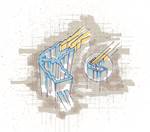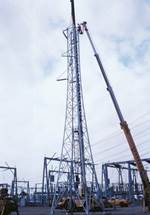A Different, All-Composite Approach
Fiberglass Structural Engineering Inc. (FSE, Bellingham, Wash., U.S.A.) has patented its innovative concept for a hybrid fiberglass and steel platform. Approximately 50 percent of the volume of a conventional steel spar hull would be replaced by hollow filament-wound Eglass and vinyl ester tubes, from 10 ft to
    Fiberglass Structural Engineering Inc. (FSE, Bellingham, Wash., U.S.A.) has patented its innovative concept for a hybrid fiberglass and steel platform. Approximately 50 percent of the volume of a conventional steel spar hull would be replaced by hollow filament-wound Eglass and vinyl ester tubes, from 10 ft to 12 ft/3m to 3.7m in diameter and more than 120 ft/37m tall, surrounded by a rigid steel framework. The tubes, closed at the top but open at the bottom and internally pressurized to provide buoyancy, would bear against the underside of the shortened upper spar hull.
¬†¬†¬†¬†‚ÄúThe tubes and the steel structure together comprise a flotation module located between the upper hull and the lower truss structure,‚ÄĚ says FSE‚Äôs Steve Gaber. ‚ÄúTubes are located below the wave zone so that they‚Äôre subjected to less stress.‚ÄĚ
¬†¬†¬†¬†According to Gaber, the cost of the FRP for an FSE system ‚ÄĒ assuming 10 ft diameter, 120 ft long E-glass and vinyl ester tubes costing $100,000 each ‚ÄĒ is $0.18 per pound of buoyancy. Factoring in the cost of the steel framework, the cost per pound of net buoyancy is still estimated to be 10 to 20 percent less than that in all-steel construction. Because the tubes have open bottoms and are partially filled with seawater, they experience neither external hydrostatic loading nor axial tensile loads from the internal pressure. They can thus be made with thinner walls, reducing fabrication costs. Given the corrosion resistance of FRP in seawater, protective paint, cathodic protection and sacrificial anodes could be eliminated in this type of platform design.
¬†¬†¬†¬†No prototypes have been fabricated yet, and no sea trials are scheduled in the immediate future, but FSE has licensed the technology to Shell International Exploration and Production for hull production. ‚ÄúThe resistance we encounter is a ‚Äėmetallics mentality,‚Äô‚ÄĚ says Gaber. ‚ÄúPeople think that a composite platform is a fragile thing ‚ÄĒ and they‚Äôre wrong.‚ÄĚ
Related Content
-
Rocket Lab begins installation of large AFP machine for rocket production
The 99-ton AFP machine, custom-designed and built by Electroimpact, is claimed to be the largest of its kind, expecting to save around 150,000 manufacturing hours in the Neutron rocket’s production process.
-
Proving thermoplastic composites match carbon fiber/epoxy performance in road bikes
CDCQ, LxSim, Addcomp and Argon 18 collaborate to optimize a carbon fiber/PA6 bike seat post, democratizing AFP and demonstrating materials and process for future designs and production.
-
Plant tour: BeSpline/Addcomp, Sherbrooke, QC, Canada
Composites automation specialist increases access to next-gen technologies, including novel AFP systems and unique 3D parts using adaptive molds.


